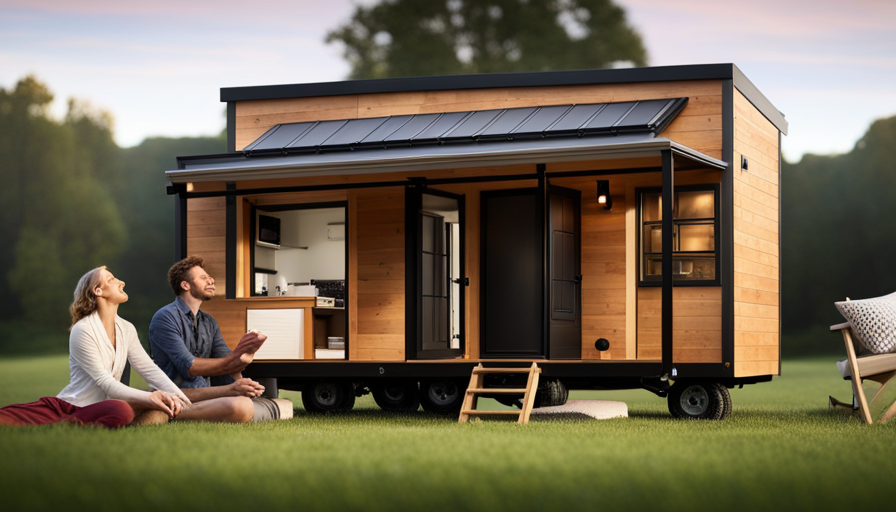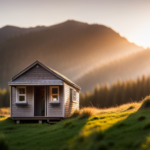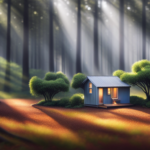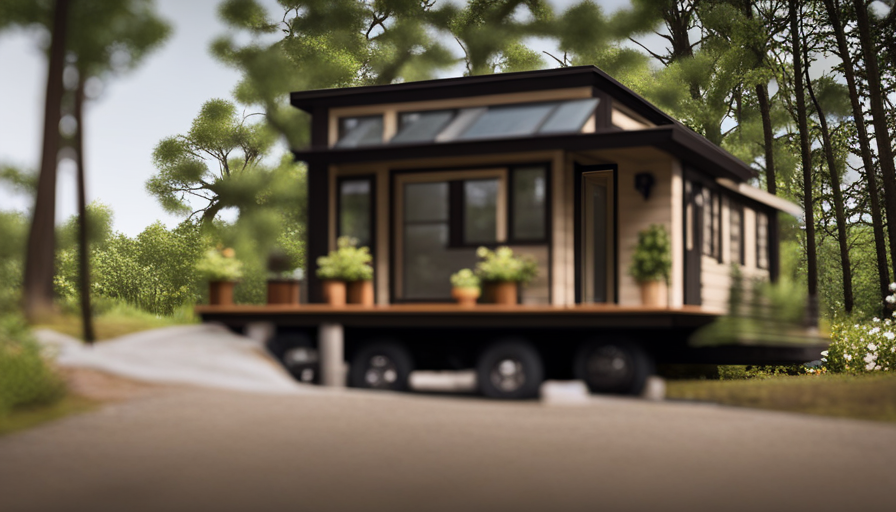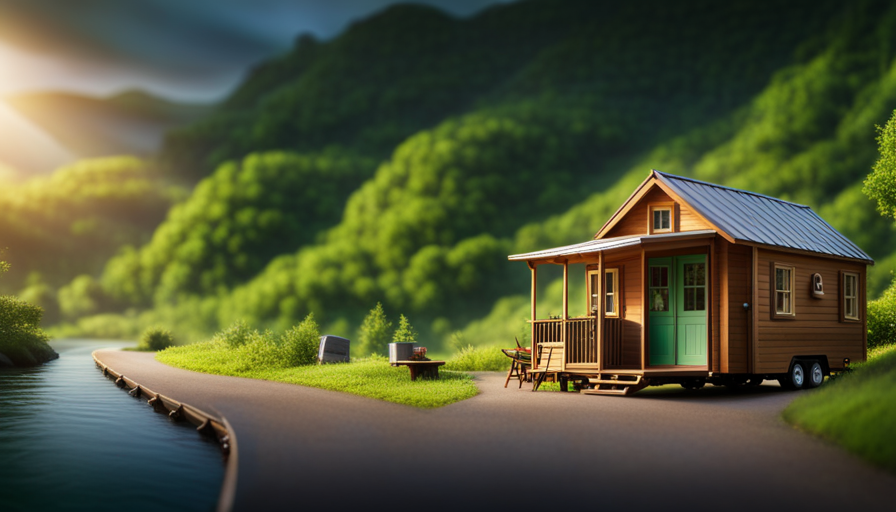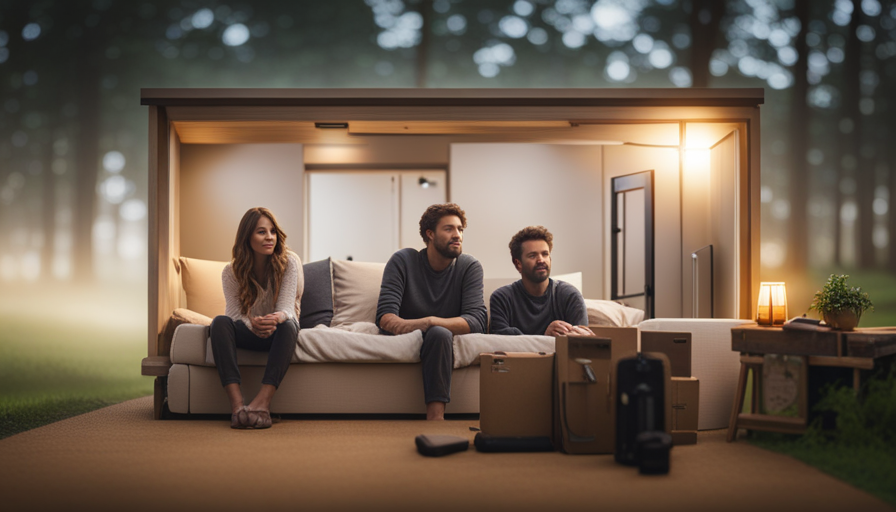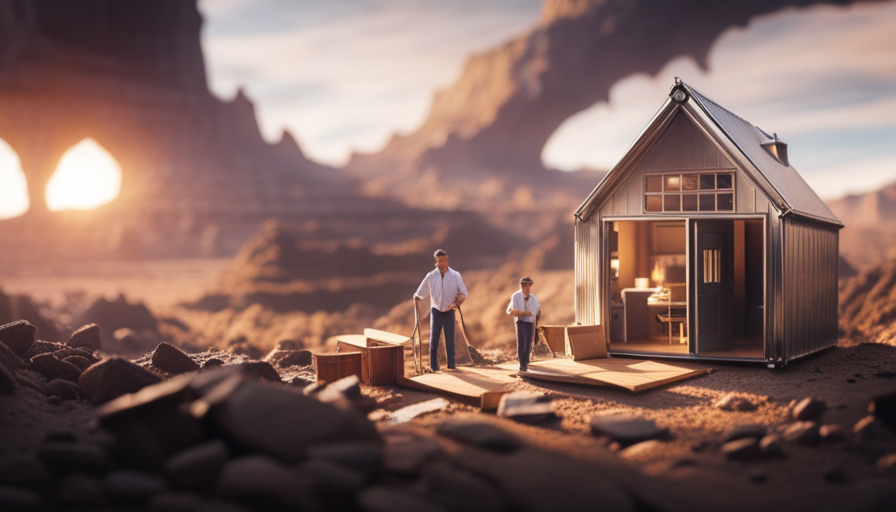Standing in front of my spacious suburban home, I felt suffocated by the abundance of space. The thought of unused rooms seemed absurd to me, and I yearned for a more simple and efficient lifestyle.
That’s when I discovered the world of tiny houses. These pint-sized dwellings offer a unique solution to the problem of excess space, allowing individuals like myself to live comfortably in a fraction of the square footage.
But as I embarked on my journey to build my own tiny house, I was faced with a crucial question: how big should my tiny house be? In this article, I will explore the various factors to consider when determining the ideal size for your tiny house. From assessing your lifestyle and needs to planning for essential spaces and functions, I will provide practical insights and advice to help you make an informed decision.
So, if you’re ready to downsize and embrace a simpler way of living, let’s dive in and discover just how big your tiny house should be.
Key Takeaways
- Assess your lifestyle and needs to determine the appropriate size for your tiny house.
- Consider your preference for indoor or outdoor space and the amount of mobility you desire.
- Take into account available space and zoning regulations when deciding on the size of your tiny house.
- Maximize functionality and space utilization by investing in multi-functional furniture and utilizing vertical storage options.
Assess Your Lifestyle and Needs
Take a moment to think about your lifestyle and what you truly need in order to create the perfect tiny house. Assessing your preferences and considering your mobility options are crucial factors to consider when determining the size of your tiny house.
Start by evaluating your lifestyle. Do you enjoy spending most of your time outdoors or do you prefer to have a cozy indoor space? If you’re someone who enjoys outdoor activities, you may want to prioritize a smaller interior space and focus more on creating outdoor living areas. On the other hand, if you’re more of a homebody, you might want to allocate more space for a comfortable and functional interior.
Another important consideration is your mobility options. Are you planning to travel frequently with your tiny house or will it be stationary? If you’re someone who loves to travel and move around, a smaller tiny house that is easier to tow or transport might be a better fit. However, if you’re looking for a more permanent residence, you can afford to have a slightly larger tiny house with more amenities and storage space.
Incorporating these factors will help you determine the ideal size for your tiny house based on your lifestyle and needs. Now, let’s consider available space and zoning regulations for your tiny house.
Consider Available Space and Zoning Regulations
Consider the dimensions and local regulations when planning the size of your compact dwelling.
Available space considerations are crucial in determining the size of your tiny house. Before making any decisions, take a careful look at the land you have available and consider any limitations or restrictions it may have. Think about the layout and design of your tiny house and how it will fit within the available space. Consider factors such as the shape of the land, existing structures, and any natural elements that may impact the placement of your tiny house.
In addition to available space, researching zoning regulations is essential. Different areas have different regulations when it comes to tiny houses. Some places may have minimum size requirements, while others may restrict the placement of tiny houses altogether. Make sure to thoroughly research and understand the zoning regulations in your area before proceeding with your plans. This will help you avoid any potential legal issues and ensure that your tiny house is in compliance with local laws.
Considering available space and zoning regulations is a crucial step in determining the size of your tiny house. It will help you make informed decisions and ensure that your compact dwelling fits seamlessly into its surroundings. Once you have a clear understanding of these factors, you can move on to the next step of determining your budget and resources.
Determine Your Budget and Resources
To determine the size of your compact dwelling, start by figuring out your budget and available resources. Imagine you have a modest budget of $30,000 and access to recycled materials from a local salvage yard, allowing you to create a charming and sustainable tiny home. Determining affordability and finding building materials are crucial steps in this process.
When it comes to determining affordability, it’s important to consider not just the initial cost of building your tiny home, but also the ongoing expenses such as utilities and maintenance. Creating a budget will help you prioritize your spending and ensure you stay within your means. Remember to factor in any additional costs, such as permits and inspections.
Finding building materials that fit your budget and sustainability goals can be a fun and creative process. By utilizing recycled materials, you not only save money but also reduce environmental impact. Check out the table below for some ideas on where to find affordable building materials:
| Source | Description |
|---|---|
| Local Salvage Yard | Recycled wood and bricks |
| Habitat for Humanity | Reusable appliances |
| Online Marketplaces | Secondhand furniture |
| Construction Sites | Leftover building materials |
| Community Reuse Centers | Various construction materials |
In the next section, we will discuss how to plan for essential spaces and functions in your tiny home. It’s important to consider your lifestyle and prioritize the features that are most important to you.
Plan for Essential Spaces and Functions
Make sure you prioritize the essential spaces and functions that are most important to you when planning your compact dwelling. When it comes to tiny houses, maximizing functionality is key. Get creative with space utilization to make the most out of every square inch.
Consider the following when planning your essential spaces:
-
Living area: Design a multipurpose space that can serve as a living room, dining area, and even a workspace. Look for furniture that can be folded or transformed to save space.
-
Kitchen: Optimize your kitchen by choosing compact appliances and utilizing vertical storage. Consider installing a fold-out dining table to save space when not in use.
When planning your essential functions, think about what you absolutely need in your tiny house:
-
Sleeping area: Decide if you prefer a loft bed or a convertible sofa bed. Look for storage solutions underneath or within the sleeping area to maximize space.
-
Bathroom: Consider a wet bath design to save space, where the shower, toilet, and sink share the same area.
By prioritizing these essential spaces and functions, you can ensure that your tiny house will be both functional and comfortable.
In the next section, we will discuss how to prioritize storage solutions and organization to further optimize your compact living space.
Prioritize Storage Solutions and Organization
Get creative with storage solutions and organization to make the most of your compact living space and keep everything neat and tidy. Maximizing storage is crucial in a tiny house, so it’s important to think outside the box and utilize every available space. Here are some creative organization ideas to consider:
-
Multi-functional furniture: Invest in furniture pieces that can serve multiple purposes, such as a sofa with built-in storage or a bed with drawers underneath.
-
Vertical storage: Make use of vertical space by installing floating shelves or hanging organizers on walls. This not only adds storage but also keeps items within easy reach.
-
Hidden storage: Look for hidden storage options, like ottomans with hidden compartments or coffee tables with lift-up tops. These clever solutions provide extra storage without taking up additional space.
Consider incorporating these ideas into your tiny house design to optimize storage and organization. By maximizing storage and getting creative with organization, you can create a clutter-free and efficient living space. Now let’s explore how to optimize layout and use of vertical space in order to make the most of your tiny house.
Optimize Layout and Use of Vertical Space
Maximize the potential of your compact living space by optimizing layout and utilizing vertical space effectively. When it comes to tiny house living, every inch counts. Maximizing vertical space is key to creating a functional and organized living environment.
Here are some creative storage solutions and tips to help you make the most of your vertical space:
-
Install floating shelves: These provide additional storage space without taking up valuable floor space. They can be used to store books, decorative items, or even kitchen essentials.
-
Utilize wall-mounted hooks and racks: These are perfect for hanging coats, hats, bags, and other items that would otherwise clutter your limited floor space. They can also be used in the kitchen to hang pots, pans, and utensils.
-
Invest in a loft bed: By raising your bed off the ground, you can create extra storage space underneath. This area can be used for clothing, shoes, or even a small workspace.
-
Use vertical storage units: Opt for tall bookcases, shelving units, or cabinets that reach the ceiling. This not only maximizes storage space but also draws the eye upward, making the room feel larger.
Maximizing vertical space and incorporating creative storage solutions are essential in a tiny house.
In the next section, we’ll explore the importance of thinking about multi-purpose furniture and flexible design.
Think About Multi-Purpose Furniture and Flexible Design
Consider incorporating multi-purpose furniture and flexible design into your living space to maximize functionality and adaptability.
When designing for small spaces, it’s essential to think outside the box and find furniture pieces that serve multiple purposes. Multi-functional furniture ideas are abundant and can help you make the most out of your tiny house.
One popular option is a sofa that can transform into a bed. This allows you to have a comfortable seating area during the day and a cozy sleeping space at night.
Another idea is a dining table that can be folded down when not in use, creating extra floor space. Additionally, consider investing in storage ottomans or benches that can double as seating and provide hidden storage for your belongings.
Flexible design is also crucial in maximizing the functionality of your tiny house. Look for furniture pieces that can be easily rearranged to serve different purposes. For example, modular shelving units can be configured in various ways to accommodate your changing needs. Additionally, consider using curtains or sliding doors instead of traditional doors, as they take up less space and provide more flexibility in room arrangement.
By incorporating multi-purpose furniture and flexible design into your tiny house, you can optimize the limited space available to you. This will allow you to adapt your living space as your needs change.
In the next section, we’ll explore how to factor in future growth and adaptability without compromising on space.
Factor in Future Growth and Adaptability
When thinking about the future growth and adaptability of your living space, it’s important to remember that 72% of people end up needing more storage space within the first year of moving into a new home. This statistic highlights the need for careful planning when it comes to designing a tiny house that can accommodate future expansion and adaptability.
To ensure your tiny house can grow with you, consider the following factors:
-
Future Expansion:
- Build your tiny house on a foundation with the option to add additional rooms or levels in the future.
- Include a loft space that can be converted into a bedroom or office as your needs change.
- Plan for possible extensions or modular additions that can be easily incorporated into the existing structure.
-
Adaptability Planning:
- Use flexible and versatile furniture that can be rearranged or repurposed as your living requirements evolve.
- Incorporate ample storage solutions, such as built-in cabinets and hidden compartments, to accommodate future storage needs.
- Design an open floor plan that allows for easy modifications and reconfigurations.
By considering future expansion and adaptability in your tiny house design, you can ensure that your living space will meet your changing needs over time.
Now, let’s explore how seeking inspiration and learning from others’ experiences can further inform your decision-making process.
Seek Inspiration and Learn from Others’ Experiences
Looking for inspiration and learning from others’ experiences can greatly enhance your journey of designing a tiny house that perfectly suits your needs and desires. When it comes to designing a tiny house, it’s essential to seek out inspiration from various sources, such as books, magazines, online forums, and social media platforms. By exploring different design ideas and considering the challenges faced by others, you can gain valuable insights and avoid potential pitfalls.
One challenge that many tiny house owners face is maximizing space without compromising on functionality. By studying design trends and innovative solutions adopted by others, you can discover creative ways to make the most of every square inch in your tiny house. From multi-purpose furniture to clever storage solutions, there are numerous design ideas that can help you create a space that feels open and spacious.
Additionally, learning from others’ experiences can provide you with valuable information about what works and what doesn’t in tiny house living. By hearing about the challenges and successes of others, you can avoid making costly mistakes and make informed decisions about your own design.
Seeking inspiration and learning from others’ experiences is a crucial step in designing your ideal tiny house. By discussing challenges and exploring design trends, you can gather ideas and insights that will inform your own design choices.
Transitioning into the next section, it’s also important to consult with professionals and experts in tiny house design and construction to ensure that your vision becomes a reality.
Consult with Professionals and Experts in Tiny House Design and Construction
To truly bring your vision to life, it’s essential to collaborate with professionals and experts who specialize in the design and construction of compact dwellings. Seeking professional advice is crucial when it comes to designing and building a tiny house that meets your specific needs and desires. Here are four reasons why consulting with professionals is important:
-
Expertise: Professionals have years of experience and knowledge in tiny house design and construction. They can provide valuable insights and guidance based on their expertise in the field.
-
Code Compliance: Building codes and regulations vary from location to location. Consulting with professionals ensures that your tiny house meets all the necessary requirements and is compliant with local building codes.
-
Space Optimization: Designing a tiny house requires careful consideration of space utilization. Professionals can help you explore design options that maximize functionality and storage, making the most out of every square foot.
-
Cost Efficiency: Building a tiny house involves making smart choices to optimize costs. Professionals can assist you in selecting cost-effective materials and suggest design alternatives that fit within your budget.
By consulting with professionals and experts in tiny house design and construction, you can gain valuable insights and ensure that your tiny house is well-designed, functional, and cost-effective. So, don’t hesitate to reach out to these professionals and explore design options for your dream tiny house.
Frequently Asked Questions
How do I decide on the size of my tiny house based on my lifestyle and needs?
When deciding on the size of my tiny house, I start by considering my lifestyle and needs. I assess my daily routines, hobbies, and space requirements.
I gather design ideas that align with my preferences and prioritize functionality. It’s important to remember that a tiny house should still accommodate my lifestyle comfortably.
By conducting a thorough lifestyle assessment and incorporating practical design elements, I can determine the ideal size of my tiny house.
What are the zoning regulations and available space considerations when building a tiny house?
When considering zoning regulations and available space considerations for building a tiny house, it’s crucial to research local zoning laws and building codes. These regulations may dictate the minimum square footage, setback requirements, and even the type of foundation allowed.
Additionally, available space considerations include factors such as the size of your property, access to utilities, and any existing structures that may affect the placement of your tiny house.
It’s important to thoroughly understand these factors before beginning your tiny house project.
How do I determine my budget and available resources for building a tiny house?
Determining the budget and gathering resources for building a tiny house is like embarking on a treasure hunt. It requires careful planning and research to unearth the financial possibilities and available materials.
Start by assessing your financial situation and setting a realistic budget. Then, explore different avenues for gathering resources, such as salvaging materials, bartering, or crowdfunding.
Be resourceful and creative, and you’ll uncover a wealth of opportunities to make your tiny house dreams a reality.
What are the essential spaces and functions that should be included in a tiny house design?
When designing a tiny house, it’s important to consider essential spaces. These include a home office and guest space. To incorporate them efficiently, I suggest utilizing multi-functional furniture. For example, a desk that doubles as a dining table or a sofa bed for guests.
For innovative space-saving ideas in the kitchen, consider using vertical storage solutions and compact appliances.
In the bathroom, opt for a shower stall with built-in storage and a wall-mounted toilet to maximize space.
What are some storage solutions and organizational tips for maximizing space in a tiny house?
When it comes to storage solutions and maximizing space in a tiny house, vertical organization is key. Utilizing wall space with shelves, hooks, and hanging storage systems can help keep belongings off the floor and create more usable space.
Additionally, using multi-functional furniture with built-in storage compartments can help maximize storage capacity. Think about incorporating storage under stairs, in loft spaces, and utilizing hidden storage areas throughout the house. These strategies can make a big difference in making the most of a small space.
Conclusion
So there you have it, folks! After considering your lifestyle, available space, and budget, it’s time to start planning your tiny house.
Remember to prioritize essential spaces, think about storage solutions, and consider multi-purpose furniture. Don’t forget to factor in future growth and adaptability, and seek inspiration from others’ experiences.
And if you’re feeling overwhelmed, don’t hesitate to consult with professionals and experts in tiny house design and construction. With a little creativity and planning, you can create the perfect tiny house that fits your needs and lifestyle.
Happy building!
Hi, I’m Emma. I’m the Editor in Chief of Tiny House 43, a blog all about tiny houses. While tree houses are often associated with childhood, they can be the perfect adult retreat. They offer a cozy space to relax and unwind, surrounded by nature. And since they’re typically built on stilts or raised platforms, they offer stunning views that traditional homes simply can’t match. If you’re looking for a unique and romantic getaway, a tree house tiny house might just be the perfect option.

